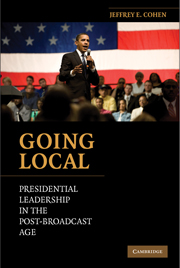Book contents
- Frontmatter
- Contents
- List of Figures
- List of Tables
- Introduction
- 1 Context and Presidential Leadership Styles
- 2 Increasing Presidential Attention to Narrow Groups
- 3 Presidents and the Local News Media
- 4 A Theory of Presidential News Management and Local News Coverage
- 5 The Quantity of Local Newspaper Coverage of the President
- 6 Trends in Local Newspaper Coverage of the Presidency, 1990–2007
- 7 On the Tone of Local Presidential News
- 8 Local Presidential News Coverage and Public Attitudes toward the President
- 9 Conclusions: Presidential Leadership in the Post-Broadcast Age
- Bibliography
- Index
1 - Context and Presidential Leadership Styles
Published online by Cambridge University Press: 05 June 2012
- Frontmatter
- Contents
- List of Figures
- List of Tables
- Introduction
- 1 Context and Presidential Leadership Styles
- 2 Increasing Presidential Attention to Narrow Groups
- 3 Presidents and the Local News Media
- 4 A Theory of Presidential News Management and Local News Coverage
- 5 The Quantity of Local Newspaper Coverage of the President
- 6 Trends in Local Newspaper Coverage of the Presidency, 1990–2007
- 7 On the Tone of Local Presidential News
- 8 Local Presidential News Coverage and Public Attitudes toward the President
- 9 Conclusions: Presidential Leadership in the Post-Broadcast Age
- Bibliography
- Index
Summary
Context shapes presidential leadership styles and the effectiveness of those leadership styles. Presidents select leadership styles that best exploit the opportunities provided by the contexts they face. This perspective on presidential leadership departs significantly from much research on the presidency, which tends to argue that personal and individual factors, such as personality, worldview, and character shape a president's leadership style (e.g., Barber, 2009; Greenstein, 2000, 2008).
I am not the only presidential scholar to emphasize the importance of context in structuring a president's leadership style. For instance, Samuel Kernell's (1986, 2006) “going public” theory argues that the change from institutional to individual pluralism affected the way presidents interact with Congress, transforming a style that emphasized bargaining to one that entailed going public. Kernell rightly points to change in the congressional context as a primary causal factor that led presidents to replace bargaining with going public in the 1960s and 1970s. One of the aims of this book is to build on Kernell's key insight about the importance of context in the formation of a general theory of presidential leadership, one that not only explains the factors that motivate presidents to adopt one leadership style over another, but also assesses the effectiveness of each major leadership style.
- Type
- Chapter
- Information
- Going LocalPresidential Leadership in the Post-Broadcast Age, pp. 11 - 34Publisher: Cambridge University PressPrint publication year: 2009



